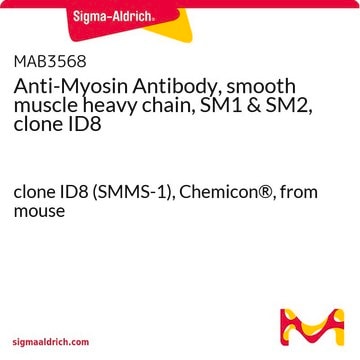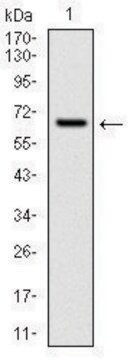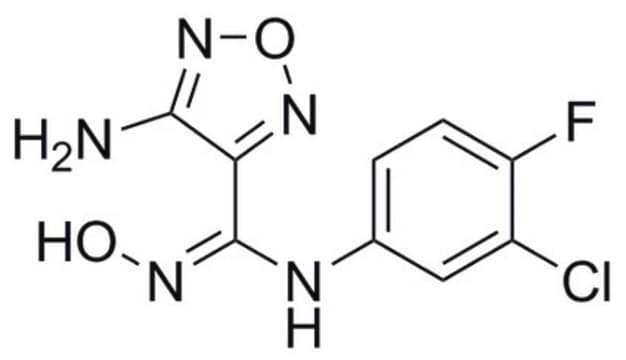AB1258
Anti-Cytochrome P450 Enzyme CYP1A1 Antibody
serum, Chemicon®
Sign Into View Organizational & Contract Pricing
All Photos(1)
About This Item
UNSPSC Code:
12352203
eCl@ss:
32160702
NACRES:
NA.41
Recommended Products
biological source
rabbit
Quality Level
antibody form
serum
antibody product type
primary antibodies
clone
polyclonal
species reactivity
human
manufacturer/tradename
Chemicon®
technique(s)
immunohistochemistry: suitable
western blot: suitable
NCBI accession no.
UniProt accession no.
shipped in
dry ice
target post-translational modification
unmodified
Gene Information
human ... AHRR(57491)
Specificity
Reacts with human cytochrome P450 CYP1A1 in human placental microsomal fraction and to recombinant human CYP1A1.
Immunogen
Synthetic peptide
Application
Anti-Cytochrome P450 Enzyme CYP1A1 Antibody detects level of Cytochrome P450 Enzyme CYP1A1 & has been published & validated for use in IH & WB.
Research Category
Metabolism
Metabolism
Research Sub Category
Enzymes & Biochemistry
Enzymes & Biochemistry
Western blot
Immunohistochemistry
Optimal working dilutions must be determined by end user.
Immunohistochemistry
Optimal working dilutions must be determined by end user.
Linkage
Replaces: MAB3522
Physical form
Rabbit antiserum. Liquid, no preservatives.
Storage and Stability
Maintain at -20°C in undiluted aliquots for up to 12 months. Avoid repeated freeze/thaw cycles.
Legal Information
CHEMICON is a registered trademark of Merck KGaA, Darmstadt, Germany
Disclaimer
Unless otherwise stated in our catalog or other company documentation accompanying the product(s), our products are intended for research use only and are not to be used for any other purpose, which includes but is not limited to, unauthorized commercial uses, in vitro diagnostic uses, ex vivo or in vivo therapeutic uses or any type of consumption or application to humans or animals.
Not finding the right product?
Try our Product Selector Tool.
Storage Class Code
10 - Combustible liquids
WGK
WGK 1
Flash Point(F)
Not applicable
Flash Point(C)
Not applicable
Certificates of Analysis (COA)
Search for Certificates of Analysis (COA) by entering the products Lot/Batch Number. Lot and Batch Numbers can be found on a product’s label following the words ‘Lot’ or ‘Batch’.
Already Own This Product?
Find documentation for the products that you have recently purchased in the Document Library.
Y Kapelyukh et al.
Drug metabolism and disposition: the biological fate of chemicals, 47(8), 907-918 (2019-05-31)
Cytochrome P450s CYP1A1 and CYP1A2 can metabolize a broad range of foreign compounds and drugs. However, these enzymes have significantly overlapping substrate specificities. To establish their relative contribution to drug metabolism in vivo, we used a combination of mice humanized
Xiao-Fei Yin et al.
Oncology reports, 30(1), 364-370 (2013-04-23)
Aryl hydrocarbon receptor (AhR) is a ligand-activated transcription factor associated with tumor initiation and progression. AhR expression is significantly increased in gastric cancer tissues and gastric cancer cell lines; however, the relationship between AhR and gastric cancer is still unclear.
Tie-Li Peng et al.
World journal of gastroenterology, 15(14), 1719-1729 (2009-04-11)
To determine the functional significance of aryl hydrocarbon receptor (AhR) in gastric carcinogenesis, and to explore the possible role of AhR in gastric cancer (GC) treatment. RT-PCR, real-time PCR, and Western blotting were performed to detect AhR expression in 39
D C Koch et al.
Oncogene, 34(50), 6092-6104 (2015-04-14)
The aryl hydrocarbon receptor (AhR) is a ligand-activated transcription factor and a member of the basic helix-loop-helix PER/ARNT/SIM family of chemosensors and developmental regulators. The AhR is widely known as a mediator of dioxin toxicity; however, it also suppresses cancer
Xiao-Fei Yin et al.
Journal of experimental & clinical cancer research : CR, 31, 46-46 (2012-05-18)
Aryl hydrocarbon receptor (AhR) is a ligand-activated transcription factor associated with gastric carcinogenesis. 3,3'-Diindolylmethane (DIM) is a relatively non-toxic selective AhR modulator. This study was to detect the effects of DIM on gastric cancer cell growth. Gastric cancer cell SGC7901
Our team of scientists has experience in all areas of research including Life Science, Material Science, Chemical Synthesis, Chromatography, Analytical and many others.
Contact Technical Service







